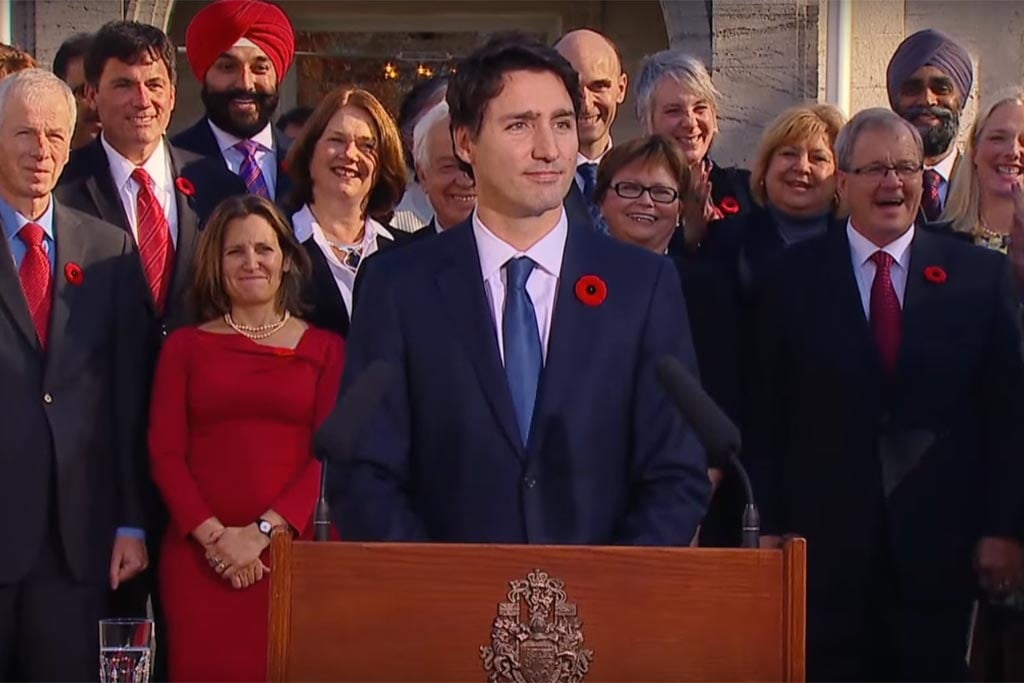Canada’s New Babe PM Appoints The Nation’s First Gender-Equal Cabinet; Becomes Even Bigger Babe
When a reporter asked him why this was important? "Because it's 2015."

Canada’s new Prime Minister Justin Trudeau has been known for many things over his 43 years. First, he was the son of Pierre Trudeau: the beloved intellectual and former Prime Minister who led the country for a total of 15 years through the ’70s and early ’80s. Then, he developed a political legacy of his own. For the better part of the past decade, he eagerly rose through the ranks of Canada’s centre-left Liberal Party affirming his support behind environmentalist causes, pro-choice legislation, drug legalisation and freedom of religion, eventually earning his role as their leader.
Then a couple of weeks ago — as he reached the pinnacle of his political career becoming the second youngest Canadian Prime Minister in history — this was all quickly eclipsed for some reason.
Canada, how is it even legal for your new prime minister to look like this. pic.twitter.com/oVa5wao2ek
— Benjamin Law (@mrbenjaminlaw) October 20, 2015
Hnnnnnnng.
Me: This is the new Prime Minister of Canada. Krissy: Are you joking? Me: No. Krissy: We're moving to Canada. pic.twitter.com/gdL8c2zsy2
— John Scalzi (@scalzi) October 20, 2015
Ugnnnnhhhhhhh.
For real though, congrats Canada on your hot grown-up-Hogwarts-student Prime Minister pic.twitter.com/XWbhIiF9lK
— Chris Person (@Papapishu) October 20, 2015
What? No. You’re mistaken. I certainly did not comb YouTube to find this old clip of him stripping in a charity auction. That must have been you.
Now — as the initial shock of seeing a political leader elected who doesn’t remotely resemble a sack of shrivelled old potatoes starts to subside — the world is now starting to learn a little bit about the brains beneath those magnificent curls. At a ceremony early this morning, Trudeau was officially sworn in as Prime Minister and unveiled much of his plans for the nation.
Unlike his conservative predecessor Stephen Harper, Trudeau affirmed a commitment to “government by cabinet” rather than one centred around his personal office. He maintained his commitment to settle 25,000 Syrian refugees by the end of the year. Then, he unveiled the cabinet. True to his pre-election promise, it featured an equal number of men and women and is in fact the most diverse in Canada’s history.
With a total of 15 women, the 30-person cabinet features ministers from each of the country’s 10 provinces including First Nation and Muslim Canadians, a Sikh immigrant, and a quadriplegic former paralympian. In his announcement, Trudeau described it as “a cabinet that looks like Canada” and when questioned by a reporter why this was important to him, he replied: “Because it’s 2015”.
Compared to the global averages, appointing this number of women is no small feat. According to the UN, only 22 percent of all national parliamentarians are female and this number drops to 17 percent when you solely focus on government ministers; they also note these women are often confined to departments relating to education and family.
As the Labor Party loved to point out during Tony Abbott’s rule, Australia has been particularly terrible in this department. While Canada, Rwanda and New Zealand previously had 12, 11 and 6 female cabinet members respectively, we trailed back on a lowly one. Since Malcolm Turnbull’s appointment that number’s been bumped up to five, but many are now making a stand for parity inspired by Trudeau’s lead. The matter was brought up with the PM in Canberra this afternoon.
“In an ideal world you would have fifty-fifty but we don’t have fifty-fifty men and women in the parliament,” he told reporters. “The fundamental problem at the root of the issue is this: there are not enough women in the House of Representatives [and] in the Senate.”
Of course, many would argue the fundamental problem at the root of the issue is that women have suffered centuries of systemic discrimination in the political arena and have long been pushed out or disadvantaged by boy’s clubs (some metaphorical, some mind-boggling literal — members of Turnbull’s own party regularly hold events at one of the only mens-only clubs in the country).
But I do agree with what he went on to say: “[More women should put] their hat in the ring and have a go”.
Thankfully Canada has a surplus of prominent female leaders (and one increasingly attractive PM) to show them the way. Australia may not quite be there yet.